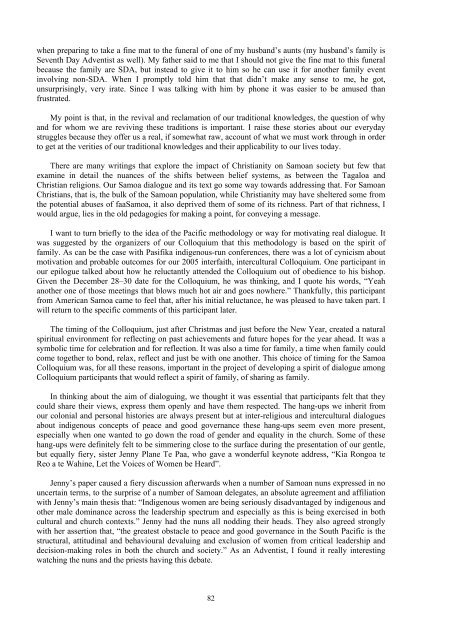traditional knowledge conference 2008 te tatau pounamu
traditional knowledge conference 2008 te tatau pounamu
traditional knowledge conference 2008 te tatau pounamu
You also want an ePaper? Increase the reach of your titles
YUMPU automatically turns print PDFs into web optimized ePapers that Google loves.
when preparing to take a fine mat to the funeral of one of my husband’s aunts (my husband’s family isSeventh Day Adventist as well). My father said to me that I should not give the fine mat to this funeralbecause the family are SDA, but ins<strong>te</strong>ad to give it to him so he can use it for another family eventinvolving non-SDA. When I promptly told him that that didn’t make any sense to me, he got,unsurprisingly, very ira<strong>te</strong>. Since I was talking with him by phone it was easier to be amused thanfrustra<strong>te</strong>d.My point is that, in the revival and reclamation of our <strong>traditional</strong> <strong>knowledge</strong>s, the question of whyand for whom we are reviving these traditions is important. I raise these stories about our everydaystruggles because they offer us a real, if somewhat raw, account of what we must work through in orderto get at the verities of our <strong>traditional</strong> <strong>knowledge</strong>s and their applicability to our lives today.There are many writings that explore the impact of Christianity on Samoan society but few tha<strong>te</strong>xamine in detail the nuances of the shifts between belief sys<strong>te</strong>ms, as between the Tagaloa andChristian religions. Our Samoa dialogue and its <strong>te</strong>xt go some way towards addressing that. For SamoanChristians, that is, the bulk of the Samoan population, while Christianity may have shel<strong>te</strong>red some fromthe po<strong>te</strong>ntial abuses of faaSamoa, it also deprived them of some of its richness. Part of that richness, Iwould argue, lies in the old pedagogies for making a point, for conveying a message.I want to turn briefly to the idea of the Pacific methodology or way for motivating real dialogue. Itwas sugges<strong>te</strong>d by the organizers of our Colloquium that this methodology is based on the spirit offamily. As can be the case with Pasifika indigenous-run <strong>conference</strong>s, there was a lot of cynicism aboutmotivation and probable outcomes for our 2005 in<strong>te</strong>rfaith, in<strong>te</strong>rcultural Colloquium. One participant inour epilogue talked about how he reluctantly at<strong>te</strong>nded the Colloquium out of obedience to his bishop.Given the December 28–30 da<strong>te</strong> for the Colloquium, he was thinking, and I quo<strong>te</strong> his words, “Yeahanother one of those meetings that blows much hot air and goes nowhere.” Thankfully, this participantfrom American Samoa came to feel that, af<strong>te</strong>r his initial reluctance, he was pleased to have taken part. Iwill return to the specific comments of this participant la<strong>te</strong>r.The timing of the Colloquium, just af<strong>te</strong>r Christmas and just before the New Year, crea<strong>te</strong>d a naturalspiritual environment for reflecting on past achievements and future hopes for the year ahead. It was asymbolic time for celebration and for reflection. It was also a time for family, a time when family couldcome together to bond, relax, reflect and just be with one another. This choice of timing for the SamoaColloquium was, for all these reasons, important in the project of developing a spirit of dialogue amongColloquium participants that would reflect a spirit of family, of sharing as family.In thinking about the aim of dialoguing, we thought it was essential that participants felt that theycould share their views, express them openly and have them respec<strong>te</strong>d. The hang-ups we inherit fromour colonial and personal histories are always present but at in<strong>te</strong>r-religious and in<strong>te</strong>rcultural dialoguesabout indigenous concepts of peace and good governance these hang-ups seem even more present,especially when one wan<strong>te</strong>d to go down the road of gender and equality in the church. Some of thesehang-ups were defini<strong>te</strong>ly felt to be simmering close to the surface during the presentation of our gentle,but equally fiery, sis<strong>te</strong>r Jenny Plane Te Paa, who gave a wonderful keyno<strong>te</strong> address, “Kia Rongoa <strong>te</strong>Reo a <strong>te</strong> Wahine, Let the Voices of Women be Heard”.Jenny’s paper caused a fiery discussion af<strong>te</strong>rwards when a number of Samoan nuns expressed in nouncertain <strong>te</strong>rms, to the surprise of a number of Samoan delega<strong>te</strong>s, an absolu<strong>te</strong> agreement and affiliationwith Jenny’s main thesis that: “Indigenous women are being seriously disadvantaged by indigenous andother male dominance across the leadership spectrum and especially as this is being exercised in bothcultural and church con<strong>te</strong>xts.” Jenny had the nuns all nodding their heads. They also agreed stronglywith her assertion that, “the grea<strong>te</strong>st obstacle to peace and good governance in the South Pacific is thestructural, attitudinal and behavioural devaluing and exclusion of women from critical leadership anddecision-making roles in both the church and society.” As an Adventist, I found it really in<strong>te</strong>restingwatching the nuns and the priests having this deba<strong>te</strong>.82
















